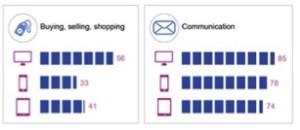I’ve been running some forecasts and conversion projections for an eCommerce email marketing strategy. It made me look for industry average email open and click through rates and website conversion rates. Mailchimp offers industry average open and click through rates (from emails sent rather than emails opened) but because website data is centric (meaning it’s not available to enquiring minds like mine), there’s no research that has industry averages for email conversion rates.
As you can imagine, there is a lot of variation between business models, between product types, between marketing strategies and most importantly between websites and their user experience and payment gateways – so their email marketing conversion rates are different as well. So to make these projections for my client, I have to use my own experience.
Converting email clicks to sales
I’m very keen on reporting so I have data on email campaigns that I’ve run over the last 5 years, where I can see my own email marketing conversion rate. I’ve run projections on the High (8%) and the Low (5%) side of these conversions, rather than the average. I figure this shows the best-case scenario.
As I work mostly with non-profits, I compared the retail industry with the non-profit sector and charity organisations. You can see a much healthier open rate for not-for-profit emails and a reasonably strong click through rate (showing good engagement from your supporters). The retail industry is enjoying higher click through rates, but we do live in a capitalist, consumer culture, so this isn’t very surprising.
Email fundraising growth
Email fundraising is still growing. When it comes to the acquisition of new supporters and the repeat conversion for existing donors, email is key. Email marketing and fundraising is especially important for the long-term retention of existing supporters.
Let’s highlight the important new, and old, aspects of fundraising:
- New: According to GlobalWebIndex, the uptake of the tablet computer has been the fastest uptake of any technology in history with up to 47% of households owning one in 2014. The way our donors are behaving online is changing quickly. On average, internet users now spend 1.85 hours a day online via a mobile device each day, up from 1.24 hours in 2012. Email is very stable, tried and true, and versatile digital channel that allows us to communicate with our supporters across all internet enabled devices.
- Old: In general, email converts at a higher rate (4.16 per cent) than organic search engine fundraising (2.64 per cent) and social media (0.48%) (Monetate 2012). Email is a direct response channel to a loyal list of supporters. Search is a sometimes warm-lead, from someone searching for information on a topic that your organisation is active in, but that doesn’t mean that they’re looking to donate, they may only be enquiring. When users are participating in social media they’re in a whole different mind frame. While they might be enticed to watch a video or click a link, moving that person from curiosity to action takes time.
The image taken below form a Roy Morgan study brilliantly summarised by Industry Acma shows that 85% of people read email communications on their desktop, 78% on their mobile and 74% on a tablet.

Base: Percentage of people aged 18 years and over who performed online activities on each device, including transactional and non-transactional activities.
Email conversion rates to online donation or sale
This graph from the Monetate Q1 2012 report shows the digital channel conversion rates over 12 months, as you can see, email is consistently the strongest.

Nowadays, many people do find email fundraising painful and SPAM has increased to record levels. However, if you implement email fundraising properly, your supporters should never receive an email from you that they didn’t request and that is not relevant to them personally.
Data from Mailchimp based on 9 million recipients shows that if you segment your email database to send more targeted messages, you are likely to get a 14 per cent better open rate and a 62 per cent better click through rate (CTR%).
What organisation is crazy enough not to invest in database cleansing and segmentation?
If you review your email reports and website analytics before planning email appeals, you can specifically re-target supporters who have visited your website recently. If your tracking is set up properly, you can tell what pages or products visitors have viewed, and whether or not they started an action or donation and then abandoned it.
Implement emails for people who abandoned their action
To get the best conversion rates, you send an email to the supporters who previously abandoned a donation in the days prior. This abandoned cart email acts as a subtle suggestion to finish what they started. And many of them will.
Amazon led the internet charge in following up on abandoned shopping carts and this tactic is now being used very effectively by email marketers and fundraisers all over the world, with increasing zeal since 2011. But I must warn you, it’s not always the easiest or cheapest thing to implement on your website. But it’s worth it. Implementing a follow up email to an abandoned donation could reap up to a 20% conversion rate – from an automated trigger-based email.
Isn’t that worth testing?
